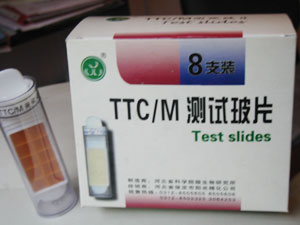 TTC/M微生物检测板说明
TTC/M微生物检测板说明
TTC/M微生物检测板荣获国家发明专利和河北省科技进步奖。是利用特定培养基提供用于一次完成细菌、霉菌/酵母菌菌落总数测定的检测装置,它使繁锁的微生物检验从实验室的束缚中解放出来,直观、准确、便捷地将测定结果展现在用户面前。该产品不需要专用的实验室和大型仪器而能够快速、简便、适合于大数量微生物标本测定的检测装置,用于测定细菌菌落总数,霉菌和酵母菌总数的测定。本项目涉及微生物检验、化工合成、模型设计等多项技术,广泛应用于水处理、化工、造纸、涂料、皮革浆料等生产行业,对加强环境监控,保持水源洁净,有效控制饮食卫生,提高企业产品质量都有深远意义,市场前景十分广阔
TTC/M DIPSLIDES
TEST FOR TOTAL BACTERIA COUNT,YEASTS AND MOULDS
TTC/M Dipslides are a combination slide for the detection of bacteria,yeasts and moulds in fluid and on surfaces. These slides provide a simple`means of enumerating these micro-organisms in industrial and environmental applications. TTC/M Dipslides find particular application for monitoring cooling water and similar recirculating water systems, natural waters and effluents and industrial cutting fluids. The range of detection for bacteria and yeasts is 101 – 106 CFU/ml for fluids. The range of detection for moulds is 101 – 103 CFU/ml for fluids.
PRINCIPLE
TTC/M Displides comprise a simple agar slide contained in a plastic test tube. The lighter color medium comprises nutrient agar for total aerobic count of bacteria(plate count). The medium contains dye which stains most colonies red for easy enumeration. The darker coloured medium comprises malt agar from the growth of yeast and moulds. Yeast appear as low round white or grey discs, moulds appear as furry colonies. After incubation the side surface are simply compare against the appropriate comparison chart to obtain the bacteria, yeast or mould count.
INSTRUCTIONS FOR USE
Test Fluids
l. Hold the Dipslide by the cap and remove from the tube. Do not touch the culture medium.
2 Immerse the slide in the fluid to be tested for about 1 0 seconds. Alternatively expose the slide to a spray or running fluid so that the slide surfaces are covered.
3 Remove the slide from the fluid and allow it to drain for a few seconds.
4 Replace the Dipslide into the tube and twist to tighten the cap. Label the tube the identification label supplied. Incubate the slide as directed later.
Incubation
After the slides have been inoculated as above they must be incubated to allow the growth of bacteria, yeasts or mould. For precise enumeration of organisms, it is important to incubate at the correct temperature. The growth of bacteria requires a different incubation temperature to that for the growth of yeasts and moulds. If enumeration of bacteria, yeast and moulds are required then it is recommended that two dipslides be inoculated and each incubated at the appropriate temperature stated below:
Bacteria : incubate at 35 - 37℃ for two days.
Yeasts and Moulds: incubate at 27 – 30℃ for two days. Note that higher temperatures may inhibit the growth. In the case of negative results, incubation for a further five days can be carried out to detect any slow growing strains.
If it is required merely to detect the presence of micro-organisms or only to get an approximate enumeration, then the slides can simply be stood in a warm place and examined after two days. If the temperature is considerably lower, than the temperatures stated above, microbial growth may be slow and it is advisable to continue incubation for a further period to detect the presence of organisms.
INTERPRETATION OF RESULTS
Compare the slide surfaces against the comparison charts printed opposite. Read the result corresponding to fluids or surfaces as appropriate. Note that very high levels of organisms could lead to a confluent growth and could be recorded as a nil result. Compare against an unused slide when leading results.





